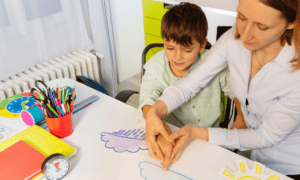This post may contain affiliate links which means I may receive a commission from purchases made through links. I will only recommend products I have personally used. Thanks.
If you’re a new mom, you must be wondering by now what age should a baby be sitting up. Sure, having an interaction mat full of toys is nice… but having both of his hands free to play with his toys since he can sit up independently? That is infant paradise.
Sitting on their own offers your little one a fresh view of the world. According to Sheryl Pitner, M.D., associate professor of pediatrics at the University of Nebraska Medical Center, sitting up allows newborns to be more autonomous and investigate their surroundings in new ways. As a parent, seeing my babies sit up independently felt like a heroic achievement and I am sure this is true for other parents.
In this article, I will discuss 7 important facts you should be aware of as a parent in relation to this important milestone-sitting up.
Once your baby’s back and neck muscles are strong enough to keep him upright and he’s worked out where to position his legs so he doesn’t tumble over, he’ll also be bridging his path to other significant milestones like crawling, standing, and walking in no time.
Want to know more? Continue reading to find out what age a baby should be sitting up, as well as 7 facts every parent should know!
When Do Babies Start Sitting Up
Wondering from which month does your baby starts sitting up? Well, there is no single, universal answer.
As per the Centers for Disease Control and Prevention (CDC), by the age of six months, most infants can sit with assistance getting into the posture, either by balancing their hands or with a bit of help from mom, dad, or a seat. Sitting independently is a skill that many infants learn between the ages of 7 and 9 months.
Each infant, however, is unique, and some may take longer or shorter to sit up on their own.
When Do Babies Sit Up from Lying Down
Now that you know what age should a baby be sitting up. Let’s move to the next milestone, which is babies sitting up from lying down! By 7 months, your little one will most likely be able to sit unassisted (freeing his hands for exploration) and will have learned how to rotate to grasp the desired object while sitting.
He could even be able to push up on his arms and move from his stomach to a sitting position at this stage. Your baby will be most likely be sitting up from lying down by the time he’s 8 months old.
What factors affect the pace of learning to sit up?
According to research, biological variables such as a developing brain and body, as well as cultural and environmental aspects, influence when a newborn learns to sit up on their own.
According to the Academy of Pediatric Physical Therapy, babies in certain cultures sit earlier than others. Babies in Kenya and Cameroon sit sooner than those in the United States and other countries, generally around 5 months. This might be because parents and caregivers provide more opportunities for these newborns to practice sitting abilities.
Holding Baby in Sitting Position
Your baby should be able to keep his head firmly when upright by four months, but most infants’ heads will still slide backward when their upper bodies are brought up to a sitting posture.
Make a game of bringing your baby up to sit to aid him to develop neck and head control: With baby resting on his back (or possibly your legs), hold his hands and slowly pull him up to sit – some funny expressions and whizzing sounds will help him enjoy the trip.
What should you do if your baby can’t sit up at 12 months?
Experts offer this rule of thumb: If your baby cannot keep his head up stably by four months and hasn’t begun learning to raise himself on his arms soon after or is unable to sit independently by nine to twelve months, consult his doctor.
It could be a good idea to act sooner, specifically, if your kid is close to 9 months old and unable to sit without assistance. Development varies from child to child; however, this might indicate a delay in gross motor skills.
Other symptoms of motor delay involve:
- Muscle stiffness or tightness
- sloppy motions
- reaches only with one hand above the other
- does not have a solid idea of the subject
- does not attempt to reach or bring things to the mouth
Babies acquire abilities at varying rates, with some developing faster than others. Still, head control is required for sitting independently, and sitting is required for crawling, standing, and learning to walk.
If you believe your kid is delayed, there is support available. Consult your doctor or nurse first or search for online assistance. Also, keep in mind that preterm newborns may miss out on this and other developmental milestones.
How to Help Baby Sit Up?
The idea is to offer your infant appropriate physical activities that acknowledge your baby’s current limitations while simultaneously encouraging your baby to push those boundaries. If you’d like to assist your baby to sit up, here are some suggestions:
- Practice Tummy Time
Your infant must have firm head control to sit up, which is best practiced during tummy time. Your baby may dislike being on their tummy at first, but it is critical to keep trying. You may start by laying them on your chest with their belly down and their face staring at you.
It is recommended that when your child is on their stomach, you should talk to them, play with them, and put some toys just out of their grasp, so they have an incentive to look around. As they spend a lot of time on their belly, they will develop tiny muscles, become more robust, and be willing to push themselves further off the floor—until one day they will be able to sit upright on their own!
-
Practice Back Time
Back-time is just as crucial for building your baby’s abdominal muscles, chest, and trunk as tummy time is for strengthening his or her neck and upper body muscles. Make him lie on his back and provide him with a toy to play with. He’ll start turning over soon, you’ll notice.
-
Encourage Baby to Roll to Their Side
You may promote your baby’s new talent by playing with him or her. To urge him to roll towards you, wiggle a toy at his side. If he manages to roll, congratulate him and rejoice. He may want your comfort because this new bodily movement might be unsettling.
-
Change Your Baby’s Position Often
Babies’ muscles often grow from head to toe, so their upper back and lower back muscles will follow once their neck muscles build. When your infant starts lifting their head off the floor to view horizontally, you’ll know their muscles are growing stronger. Change your child’s posture frequently to promote these considerable motor skills. For instance, change their position from back to belly and from bassinet to floor.
-
Help Your Baby Learn the Art of Balancing!
Before they can sit alone, babies need to learn the art of balance. Although powerful trunk muscles are advantageous, they will also require some specialized cognitive ability. Set them in the corners of chairs or couches to get a sense of what it’s like to sit. If you wish to collaborate, sit on the floor with your legs crossed, allowing them to rest safely between your calf and hamstring.
-
More Floor Time
More time on the floor may assist in developing this independence versus using seat positioners for your kid. Aim for at least two or three times a day of floor play with age-appropriate toys.
-
Use Mirrors to Encourage Sitting Up
Another excellent learning method is building enticement Babies enjoy gazing at themselves in mirrors, so position one that is just a bit too high for them to see into to urge them to sit up.
Note: Always stay close to your child, particularly when he’s just beginning to sit, in case he slips – or likes to show off his new talent.
What not to be concerned about
As long as you give your baby lots of opportunities to practice sitting, he’ll let you know when he’s ready.
Even with assistance, if your baby slumps over or falls off to one side, he may not be ready to sit, and you may try again later. Babies new to sitting up may exhaust quickly; he will let you know when he’s had enough by whining, moaning, or drooping.
What milestones are on the horizon?
Now that you’ve gathered enough information on what age should a baby be sitting up, what is the next step? Again, it differs from one baby to the next. However, as your child approaches their first birthday, you may anticipate the following trend.
- bringing oneself to a standing posture
- crawling and slithering over the floor
- first supported steps and cruising furnishings
- they are walking on their own
Once your baby has learned to sit, try nurturing their independence even more by practicing the transition from the floor to sitting. Practice will help them develop all of their core muscles and build confidence in this brand-new posture. Toys that encourage play in this posture might also be beneficial.
If you’ve any questions regarding what age a baby should be sitting up, please let us know!
Happy Sitting Up!!
Other Post you may like;
7 SIGNS A BABY IS CONSTIPATED AND EFFECTIVE HOME REMEDIES TO RELIEVE THEIR SYMPTOMS
7 EASY STEPS ON HOW TO HANDLE 2 YEAR OLD TANTRUMS
FUSSY EATING- 7 EASY STEPS TO HELP YOUR BABY GET REQUIRED NUTRIENTS
12 STEPS GUIDE TO DEALING WITH PREMATURE BIRTH
Related Posts
- When Should Baby Start Wearing Shoes - 5 Essential Facts Every Parent Should Know About Pre-walking Shoes
Do you want to get your baby their first shoes, but you’re probably stuck on…
- 10 Steps to successfully weaning your baby
Being a parent, you will surely agree that we are in a never-ending learning process.…
- 9 Easy Steps to Help your Baby Sleep Through the Night
The idea that a baby can sleep through the night is the wish of many…








